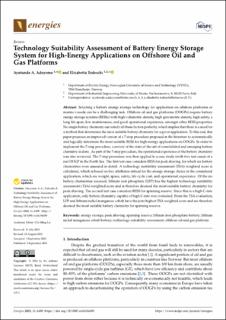| dc.description.abstract | Selecting a battery energy storage technology for application on offshore platforms or marine vessels can be a challenging task. Offshore oil and gas platforms (OOGPs) require battery energy storage systems (BESSs) with high volumetric density, high gravimetric density, high safety, a long life span, low maintenance, and good operational experience, amongst other BESS properties. No single battery chemistry can satisfy all these factors perfectly, which implies that there is a need for a method that determines the most suitable battery chemistry for a given application. To this end, this paper proposes an improved version of a 7-step procedure proposed in the literature to systematically and logically determine the most suitable BESS for high-energy applications on OOGPs. In order to implement the 7-step procedure, a review of the state-of-the-art of consolidated and emerging battery chemistry is done. As part of the 7-step procedure, the operational experience of the battery chemistry was also reviewed. The 7-step procedure was then applied to a case study (with two test cases) of a real OOGP in the North Sea. The first test case considers BESS for peak shaving, for which six battery chemistries were assessed in detail. A technology suitability assessment (TSA) weighted score is calculated, which is based on five attributes critical for the energy storage choice in the considered application, which are weight, space, safety, life cycle cost, and operational experience. Of the six battery chemistries assessed, lithium iron phosphate (LFP) has the highest technology suitability assessment (TSA) weighted score and is therefore deemed the most suitable battery chemistry for peak shaving. The second test case considers BESS for spinning reserve. Since this is a high C-rate application, only battery chemistry capable of high C-rate was evaluated. From the TSA evaluation, LFP and lithium nickel manganese cobalt have the joint highest TSA weighted score and are therefore deemed the most suitable battery chemistry for spinning reserve. | en_US |

